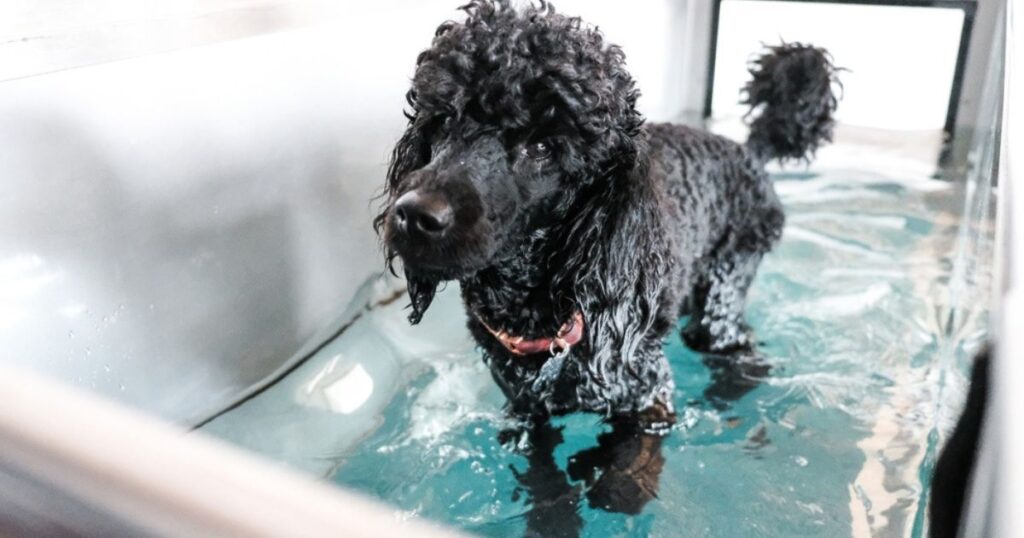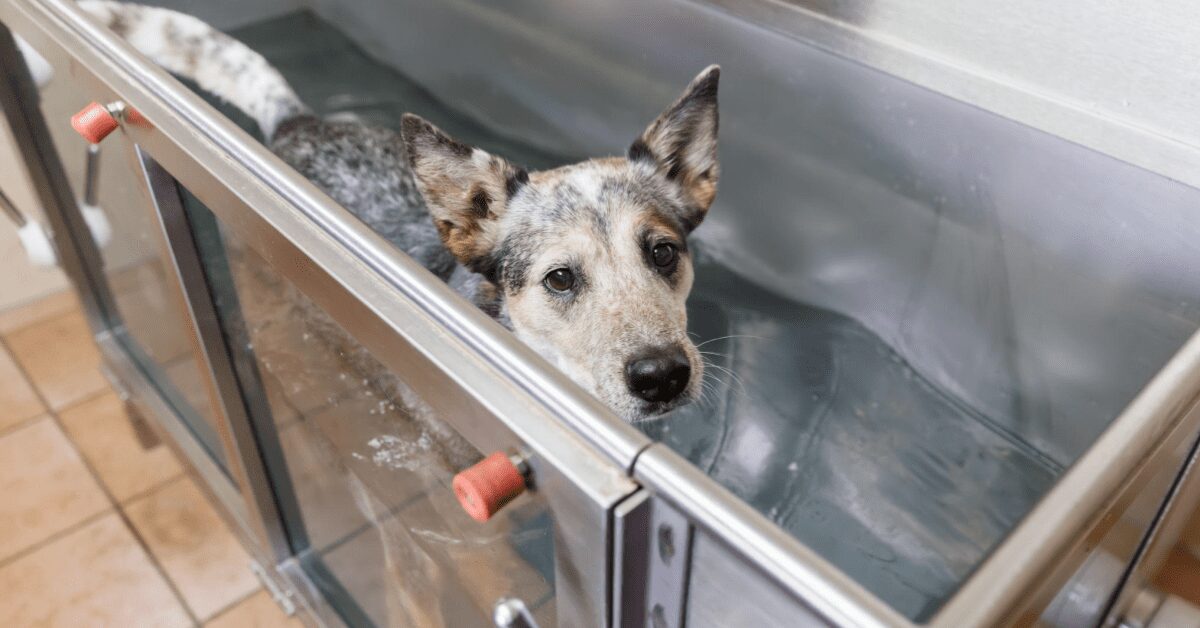Key Points
- Hydrotherapy is a great type of physical therapy for dogs that need low-impact exercise to lose weight, rehabilitate an orthopedic injury, or support aching joints.
- Your dog can experience the benefits of hydrotherapy at home or at a treatment center.
- Hydrotherapy can also be used to treat arthritis, hip dysplasia, intervertebral disc rupture, and more.
Let’s get one thing straight: There are no ice baths for dogs, but that doesn’t mean your favorite pup can’t benefit from scientifically tested hydrotherapy for dogs. In recent years, hydrotherapy has become more and more popular for dogs, and even cats, recovering from surgery, chronic conditions like osteoarthritis, and obesity.
This type of therapy can be an excellent treatment to improve your furry friend’s mobility and overall well-being. Warm water can help open blood vessels and relieve pain from sore joints and muscles. At the same time, water resistance helps boost blood circulation and build muscle mass in a low-impact environment, making it ideal for dogs suffering from hip dysplasia, arthritis, obesity, and other dog health conditions.
So, should your dog try it? Let’s consider why hydrotherapy may be the way to go.
What is hydrotherapy for dogs?
Also known as water or aquatic therapy, hydrotherapy is a low-impact physical therapy treatment that uses the benefits of water to help dogs recover from various health conditions. Dr. Jamie Whittenburg (DVM) explains, “Hydrotherapy can come in the form of swimming in a pool or walking on underwater treadmills and is used for exercise as well as rehabilitation. This exercise modality can help improve strength, increase range of motion, and build endurance.”

Hydrotherapy for dogs was inspired by therapy for horses, if you can believe it. They found that race horses responded well to the treatment, soon after it was applied to racing dogs, and now it’s widely available for dogs like Max, a 5-year-old Golden Retriever.
Max — a patient of Dr. Patrik Holmboe, head veterinarian at Cooper Pet Care — suffered from advanced hip arthritis that limited his ability to fetch and enjoy walks with his parents. Despite weight management and prescription medication, Max still struggled to get around, prompting Dr. Holmboe to prescribe weekly sessions of underwater treadmill therapy. Max loved the treats and attention he received during his hydrotherapy treadmill workouts. In addition to becoming a happier pooch, Max showed significant improvements in mobility, flexibility, and comfort level.
Benefits of hydrotherapy for dogs
Hydrotherapy for dogs can provide a multitude of benefits, such as:
- Improve strength and range of motion after surgery or injury
- Support joints of dogs with arthritis, hip dysplasia, or a joint pain flare-up
- Help improve overall blood circulation, which can benefit dogs with heart disease or lymphatic disorders
- Help overweight dogs shed some pounds
- Provide the mental and physical stimulation dogs need to stay happy!
Dr. Katie Murphy, PT, DPT, and CCRT from Sage Canine Rehabilitation Center works with animals every week who utilize hydrotherapy. She has seen firsthand that it “is a powerful therapeutic tool, providing low-impact exercise to aid in recovery from orthopedic surgeries, neurological disorders, and chronic conditions like osteoarthritis.”
Hydrotherapy can also be a great way to lift your furry friend’s spirits during a lengthy recovery, especially if you have an energetic pup who doesn’t know the meaning of “take it easy.” For instance, Dr. Thomas Doyne (DVM, MS) was caring for a hyperactive hound named Meg, who loved to run through the woods at top speed and ended up in the ditch with a broken leg. “Resting and physiotherapy didn’t seem to help much with Meg’s energetic personality, and pain medication was the only thing that kept her calm,” recalls Dr. Doyne. “That’s when we thought outside the box and decided to give hydrotherapy a shot to reduce weight on her leg and help her build strength and muscle mass.” Over the course of therapy, he measured Meg’s range of motion with gait analysis and found the treatment had worked wonders.
The accessibility of hydrotherapy is also a major advantage, as many dogs can participate regardless of age, size, or physical condition.
It’s important to make sure that hydrotherapy is a good fit for your dog before signing them up. “It may not be suitable for all pets and could sometimes exacerbate certain conditions. Consulting a certified canine rehabilitation veterinarian or physical therapist is essential to determine if hydrotherapy is the right choice for your pet,” notes Dr. Murphy. She has seen the best outcomes when hydrotherapy is also combined with other treatments like therapeutic exercises and manual therapy.
What does Hydrotherapy treat?
Hydrotherapy for dogs assists with recovery from a wide range of health problems. Here are a few of the most common reasons a dog owner may choose this type of physical therapy.
- ACL recovery
- Arthritis
- Muscle atrophy
- Paralysis
- Obesity
- Hip or elbow dysplasia
- Cruciate ligament rupture
- Neurological conditions
- Intervertebral disc rupture slipped disc
It’s important to remember that not every dog is going to love the water, which is why it’s best to start hydrotherapy with a trained professional — and a water-loving dog.
How hydrotherapy for dogs works
Hydrotherapy is different from letting your dog swim in the swimming pool, lake, or river, though these activities can have their own benefits. It involves specialized equipment that allows the dog to exercise in a controlled environment with a treatment plan from a certified team. The Sage Canine Rehabilitation Center was kind enough to share some videos so you can see what hydrotherapy can look like.
Dr. Iram Sharma, DVM, a veterinary consultant for Pupvine.com, treated an overweight Labrador suffering from muscle strains, post-traumatic arthritis, and minor hip luxation due to excessive exercise. In addition to a change in diet, joint supplements, anti-inflammatory medication, pain relievers, and vitamin B12, hydrotherapy was chosen to improve muscle mass and weight loss. After six weeks of 20-minute hydrotherapy sessions, Dr. Sharma noted significant muscle mass improvement in the affected hip region, along with a reduction in limping and improved trotting.
Remember Max, the Golden Retriever? Here’s how the treatment worked for him, according to Dr. Holmboe:
“We use a treadmill that is partially submerged, with the water level coming up to about the level of Max’s chest. The buoyancy of the water supports the dog’s body, reducing stress on his joints and allowing him to move around more freely. The underwater treadmill provides controlled exercise, helping to move and strengthen his muscles in a very low-impact way.”
Depending on your dog’s case, their hydrotherapy treatment can look similar or different from these stories. Your veterinarian should be able to help you come up with a plan that works for your dog’s unique situation.

Types of hydrotherapy for dogs
Several types of hydrotherapy are available for dogs, including:
- Swimming pool sessions
- Underwater treadmill workouts
- Immersion therapy in a heated whirlpool
Each type of therapy has its own set of benefits and can be tailored to your dog’s specific needs.
“Underwater treadmill therapy, for example,” explains Dr. Holmboe, “is often used for dogs with joint problems, while aquatic therapy is better suited for dogs recovering from surgery or with neurological conditions.”
Making a hydrotherapy plan with your veterinarian
If you think hydrotherapy is the right treatment for your dog, talk to a veterinarian. “The first step is to speak with your veterinarian about the availability of such a therapeutic modality in your area and – if necessary – obtain a referral,” says Dr. Whittenburg. “The American Association of Rehabilitation Veterinarians is a great resource as well.”
A vet or certified hydrotherapist can determine whether your pup can benefit from hydrotherapy and guide them through water exercises at a rehabilitation center.
While hydrotherapy can be an immense help in building muscle and endurance, it shouldn’t be the sole treatment for inflammation and pain. The best rehabilitation plans are individualized for each dog with a combination of treatments. Hydrotherapy can be a lengthy therapy, spanning many weeks or months, and it can be costly without pet insurance — so these factors must also be considered.
Tip: Whether your pooch is a senior dog or recovering from an injury, hydrotherapy can be a great way to improve their mobility. Pumpkin Dog Insurance plans can help pay for alternative therapies like hydrotherapy when used to treat a covered condition.
What to know before your first hydrotherapy appointment
All physical rehabilitation requires time and patience. Dr. Murphy sees dozens of dogs at the Sage rehabilitation facility, and she said that on your first visit, “come with an open mind and a lot of patience. Rehabilitation is a gradual process, and results may not be immediate. I’d also recommend communicating openly with the therapist about your pup’s daily habits, activity level, and any concerns you may have. Staying consistent with prescribed exercises or at-home care is key. And don’t forget to bring your pup’s favorite treats or toys to help them feel comfortable and relaxed during the session — it can make a big difference in their recovery journey!”
Risks and Side Effects
Although hydrotherapy can be very beneficial, it can come with a risk of ear infections if the dog’s ears are not dried properly afterward. Long-term exposure to water, if this isn’t something your dog is used to, can also irritate some skin conditions, so it’s important to ask your veterinarian before your appointment if you’re concerned.
What does hydrotherapy for dogs do?
Hydrotherapy can benefit dogs in many ways, such as increasing mobility, building strength, reducing pain, and improving blood circulation. The water provides a non-weight environment for movements that would not be possible on land due to injury, weight, or other pain. This is especially helpful to dogs suffering from joint problems and obesity.
Making the dog more buoyant, taking pressure off of joints, and providing some pain relief are just some additional benefits of water therapy. In water, dogs and humans can get the benefits of hydrostatic pressure, which is the light pressure applied by being surrounded by water. This pressure can enhance circulation and decrease swelling.
FAQs
- Frequently Asked Questions. (2022). National Association of Registered Canine Hydrotherapists. Accessed on January 24, 2023.
- Benefits of Hydrotherapy (Aquatic Therapy) For Dogs. (2022). West Chester Veterinary Medical Center. Accessed on January 24, 2023.




